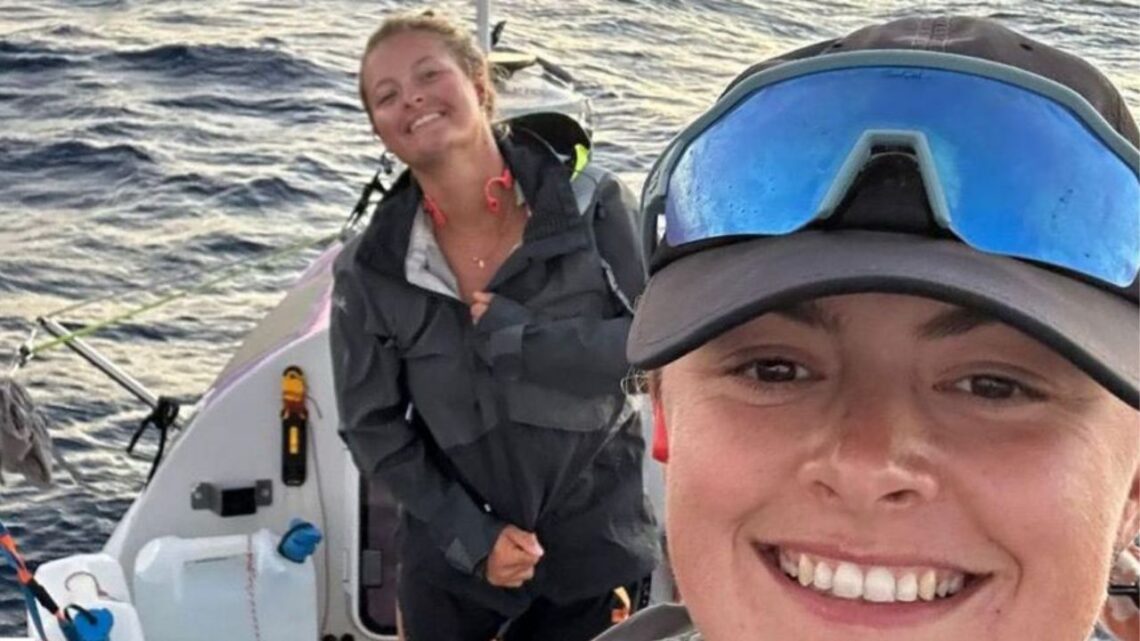Six months in a rowboat in the South Pacific Ocean might sound like a nightmare. But for British adventurers Jess Rowe, 28, and Miriam Payne, 25, the blistered hands, salt-crusted skin, and sleepless nights are all part of a once-in-a-lifetime expedition.
Their destination? Cairns, Australia—where the finish line now looms.
They launched from Lima, Peru, in May 2025 (after an earlier attempt in April ended in a rudder failure), aboard their 9-metre vessel “Velocity.” Over roughly 8,300 nautical miles (15,300 km) of open ocean, they’ve committed to rowing nonstop and unsupported, day and night.
Along the way they’ve battled the elements, equipment breakdowns, and sheer isolation—all while aiming to become the first all-female pair to complete this route.
The Journey in Detail
1. Daily Life & Routine
Rowe and Payne average ~50 nautical miles per day, rowing in two-hour shifts around the clock. As one rows, the other sleeps in their tiny cabin on thin towels. Their sleep system, meagre and fragile, forces them to rest on the move.
Their survival kit is minimal but essential:
- 400 kg of provisions, 80% freeze-dried,
- A desalinator for producing fresh water,
- Their “Dumpy” bucket loo,
- Emergency repair supplies—when a vital pipe burst, they jury-rigged a fix using cut-up underwear.
They’ve encountered 30-ft waves, endured storms that knocked out their navigation electronics, and drifted in dead calm—each stretch demanding constant vigilance. They’ve also shared the waves with sharks, whales, dolphins, turtles, sea lions, and saw stars at night unspoiled by light.
2. Power Failures & Navigation Risks
A turning point came when their solar battery system failed: the batteries were discharging too fast. To survive, they shut off almost all electronics—including the chartplotter and AIS beacon. For stretches they became a “ghost ship,” blindly navigating by manual methods and lookout.
That strain on power also jeopardized their water generator, making power conservation vital. They learned to ration energy carefully, prioritising the few systems that sustain life.
3. Route Changes & Final Challenges
Originally bound for Brisbane, the pair were thwarted by persistent headwinds in August. Thus they altered course toward Cairns, working with local advice (notably from a Cairns fisherman) to thread a safe path through the Great Barrier Reef and island passages.
In the final hours, they hope for a “long-awaited pizza” and to regain their “land legs.” Their projected arrival is Saturday, 18 October 2025, between noon and 2 pm AEST, landing at Cairns Marlin Marina.
Buoyed by letters from schoolchildren, the duo often attribute their progress to sheer stubborn determination and the mental fuel of connection with supporters back home.
Key Facts
| Metric | Detail |
|---|---|
| Team | Jess Rowe & Miriam Payne |
| Vessel | Velocity, approx. 9 metres |
| Route | Lima, Peru → Cairns, Australia (via reef passages) |
| Distance | ~8,300 nautical miles (≈15,300 km) |
| Daily Pace | ~50 nm per day |
| Shift Pattern | 2-hour rowing / 2-hour rest rotations |
| Provisions | 400 kg (80% freeze-dried) |
| Power & Water | Solar + desalinator |
| Projected ETA | 18 October 2025, ~12:00–14:00 AEST |
| Sponsorship | Fundraising for a charitable trust |
| Record Claim | First all-female pair non-stop, unsupported across South Pacific |
Unique Risks and Record Aspirations
Ocean rowing across the Pacific is rare even among mixed-gender crews or soloists. Prior attempts have ended in rescues, capsizes, or fatal outcomes.
What sets this venture apart is the aim: nonstop, unsupported, by an all-female pair—no stops, no external help.
Their mid-voyage equipment failures, the shift to manual navigation, and mental stresses of isolation make their effort not just an endurance challenge, but a test of resourcefulness under siege.
Rowe and Payne’s odyssey is a breathtaking blend of ambition, grit, and vulnerability. For months, they’ve endured sun, storm, fatigue, and isolation in a cramped rowing shell, with nothing but faith in their skills and each other.
As they near land, they stand on the verge of making history: the first all-female pair to row non-stop, unsupported across the South Pacific from Peru to Australia. Their final hours at sea may be the hardest yet—but all eyes are on Cairns, and on two rowers who refused to give up.









